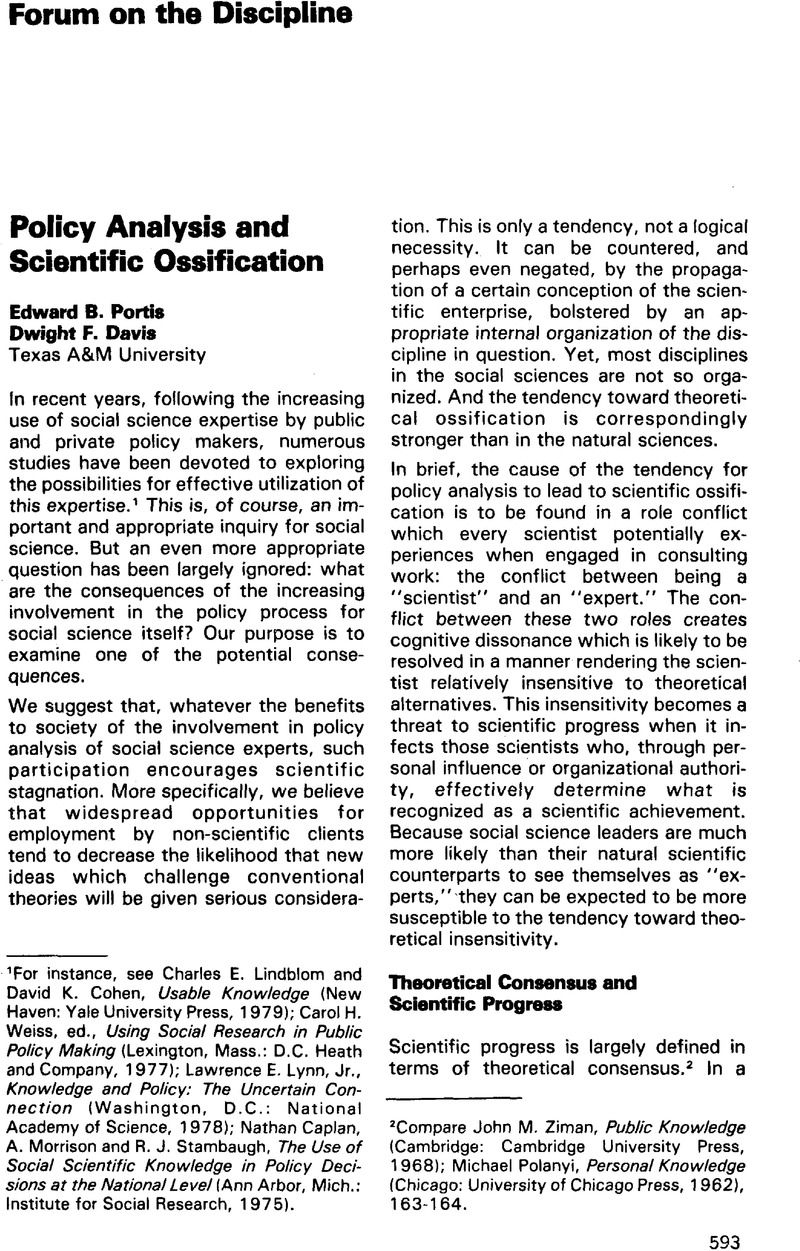Published online by Cambridge University Press: 25 November 2022

1 For instance, see Lindblom, Charles E. and Cohen, David K., Usable Knowledge (New Haven: Yale University Press, 1979)Google Scholar; Weiss, Carol H., ed., Using Social Research in Public Policy Making (Lexington, Mass.: D.C. Heath and Company, 1977)Google Scholar; Lynn, Lawrence E. Jr., Knowledge and Policy: The Uncertain Connection (Washington, D.C.: National Academy of Science, 1978)Google Scholar; Caplan, Nathan, Morrison, A. and Stambaugh, R. J., The Use of Social Scientific Knowledge in Policy Decisions at the National Level (Ann Arbor, Mich.: Institute for Social Research, 1975)Google Scholar.
2 Compare Ziman, John M., Public Knowledge (Cambridge: Cambridge University Press, 1968)Google Scholar; Polanyi, Michael, Personal Knowledge (Chicago: University of Chicago Press, 1962), 163–164 Google Scholar.
3 The nature of this consensus is a matter of some debate, and it probably includes more than just theoretical elements. But regardless of whether it is called a “paradigm,” “program” or “tradition,” most agree that it exists in a well developed science and includes a theoretical dimension. Compare Kuhn, Thomas S., The Structure of Scientific Revolutions (Chicago: University of Chicago Press, 1962)Google Scholar; Lakatos, Imre, “Falsification and the Methodology of Scientific Research Programs,” in Criticism and the Growth of Knowledge, eds. Lakatos, and Musgrave, Alan (Cambridge: Cambridge University Press, 1970)CrossRefGoogle Scholar.
4 Polanyi, Michael, Science, Faith and Society (Chicago: University of Chicago Press, 1964), 56 CrossRefGoogle Scholar.
5 Kuhn, , Scientific Revolutions, 164 Google Scholar.
6 See Karl Popper, “Normal Science and Its Dangers,” in Criticism and Growth, eds. Lakatos and Musgrave.
7 Polanyi, , Personal Knowledge, 53 Google Scholar.
8 See Weinberg, Alvin M., Reflections on Big Science (Cambridge, Mass.: The M.I.T. Press, 1967), 47–51 Google Scholar.
9 We certainly are not arguing that this is a description of how science actually operates. The consensual nature of research and resistance to change in advanced sciences are now widely recognized. For illustrations and a summary of the literature, see Blissett, Marian, Politics in Science (Boston: Little, Brown and Company, 1972)Google Scholar. We are asserting that the ethos we have described, and which is generally recognized as part of the “myth” of science, plays an indispensable role in facilitating scientific change.
10 See Weidman, Donald R., “Writing a Better RFP: Ten Hints for Obtaining More Successful Evaluation Studies,” Public Administration Review, 37 (November/December 1977)CrossRefGoogle Scholar; Nathan Caplan, “A Minimal Set of Conditions Necessary for the Utilization of Social Science Knowledge in Policy Formulation at the National Level,” in Using Social Research, ed. Weiss.
11 For development of some of the ethical implications of these observations, see Davis, Dwight F. and Portis, Edward B., “A Categorical Imperative for Social Scientific Policy Evaluation,” Administration and Society, 14 (August 1982)CrossRefGoogle Scholar.
12 Although the term is taken from Leon Festinger's work, we are not attempting to apply “dissonance theory” and certainly do not claim to have made a contribution to the extensive literature on this subject. Nevertheless, our perspective is to some extent informed by M. Brewster Smith's observations concerning its relevance to personal identity in “The Self and Cognitive Consistency,” Theories of Cognitive Consistency: A Sourcebook, Abelson, Robert P. et al. , eds. (Chicago: Rand McNally and Co., 1968)Google Scholar.
13 Of course, the relative autonomy enjoyed by natural scientists from client control creates problems of its own. See Price, Don K., The Scientific Estate (New York: Oxford University Press, 1965)Google Scholar.
14 See Hagstrom, Warren O., The Scientific Community (New York: Basic Books, 1965), 184–187 Google Scholar; Gaston, Jerry, Originality and Competition in Science (Chicago: University of Chicago Press, 1973)Google Scholar.
15 For instances of abuse of authority within science, see Manuel, Frank E., “Newton as Autocrat of Science,” Philosophers and Kings: Studies in Leadership, Rustow, Dankwart A., ed. (New York: George Braziller, 1970)Google Scholar; Koestler, Arthur, The Case of the Mid-wife Toad (New York: Random House, 1971)Google Scholar. For examples of organizational prescriptions to cope with the problem, see Polanyi, , Science, Faith and Society, 45–49 Google Scholar; Ravetz, Jerome R., Scientific Knowledge and Its Social Problems (New York: Oxford University Press, 171), 265–271 Google Scholar.